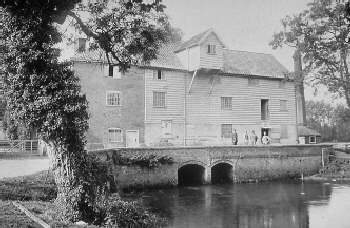 |
|
c.1910
|
|
Tasburgh Mill
River Tas |
 |
|
c.1910
|
|
Tasburgh watermill was probably once a paper mill but in 1896 it became Duffields' first roller mill. It had an auxiliary steam engine and was capable of producing two sacks an hour. This was a typical Norfolk white weatherboarded mill with a Norfolk pantile roof. The adjoining mill house under the same roof was built of Norfolk red brick. |
|
The decorative brick chimney came from Tharston and the Mill House door came from Norwich. |
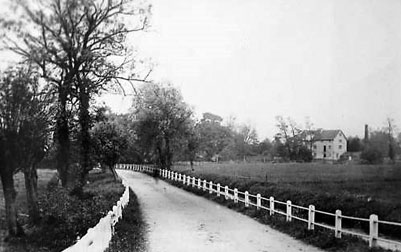 |
|
c.1912 |
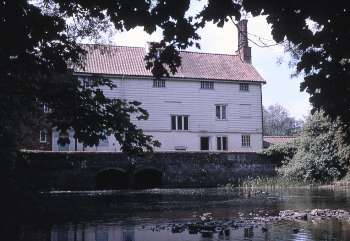 |
|
July
1967
|
|
For many years the mill was worked in conjunction with the nearby windmill. |
Royal Exchange Fire Insurance policy 77407 |
Jno. Nicklefs of Tasborough in the County of Norfolk, Miller. On his Dwelling House & Water Corn Millhouse adjoining brick & timber built & tiled & on the Mills in the said Millhouse together with the running tackle & other parts of the Machinery belonging thereto, sit. in Tasborough aforesd., £800. On a Barn, Stables & Outhouses at or near adjoining brick built & tiled sit. in the Yard belonging, £200. (Renewed from No. 56865) 5th February 1780 |
|
Zachary George was the son of King George, miller at Costessey, who died in 1813. |
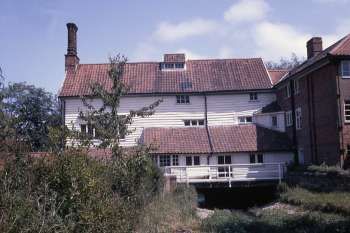 |
|
Headrace
July 1967
|
|
Capital Water Mill, Wind Mill & Land at Tasburgh,
Norfolk. |
|
Capital Water Mill, Wind_ Mill & Land at Tasburgh, Norfolk. |
|
To Millers |
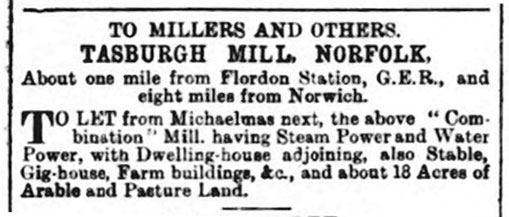 |
|
Thetford & Watton Times and People's Weekly Journal - 17th February 1894 |
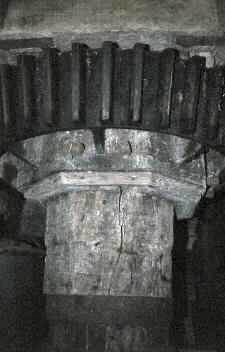 |
|
The
wallower c.1969
|
William Lant Duffield had been an apprentice at Tasburgh watermill before becoming an employee at Mulbarton_smockmill. In 1893 he started his own business by leasing Mattishall_Mill_St_towermill for four years. In 1896 William Duffield went back to Tasburgh watermill and in 1906 took over the running of Saxlingham_Thorpe_watermill thus founding the firm of W. L. Duffield & Son, Ltd. |
Norwich Bankrupts. |
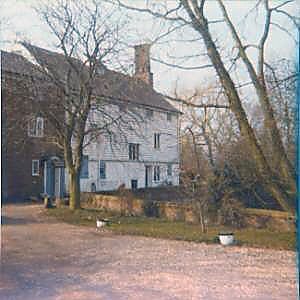 |
|
March
1977
|
Water Mill House |
This is a rare opportunity to buy a Grade II listed country house with an adjoining water mill conversion situated in an estate close to Norwich extending to approximately 14 acres. |
Couple sell 'amazing' converted water mill after two-year renovation |
A couple who renovated a historic water mill in an idyllic Norfolk village have put it on the market for £1,600,000. |
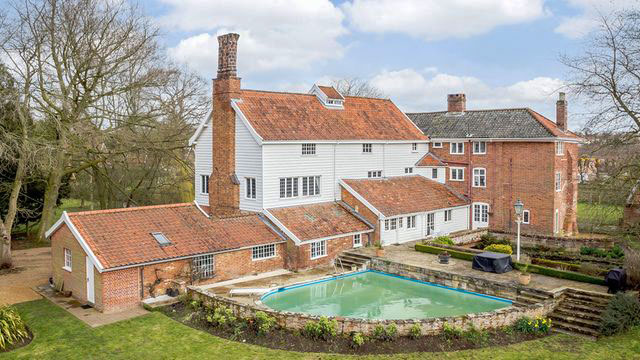 Water Mill House, Tasburgh, dates back to the 16th century but was converted into a residential dwelling in the 1930s and has now been further renovated - Credit: William H Brown |
The mill's original workings can still be seen in a glazed off room on the ground floor, and you can still hear the sound of water, as the River Tas runs directly underneath. "You can hear the river all the time," Rebecca says - although she's keen to point out that you can also shut it off, closing doors to create privacy within the house. |
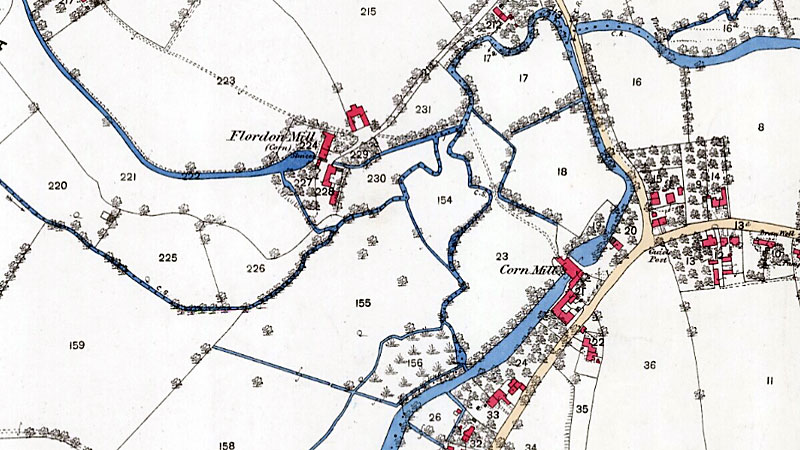 |
O. S. 25" Map 1882 (not to scale) |
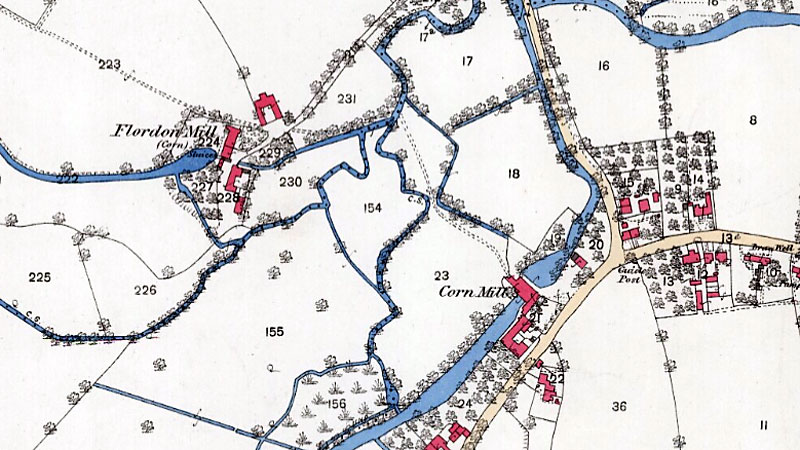 |
O. S. 25" Map 1882 (not to scale) |
The above map clearly shows the dotted line of the parish boundaries tracing the original paths of the rivers. The River Tas used to run to the west of the mill rejoining the main river course well to the north of Tasburgh mill, with a considerable section having been dug in order to accommodate the mill. It would appear that an even longer new section was excavated to allow for the construction of Flordon_mill, although both could have involved the enlarging of existing smaller watercourses.
|
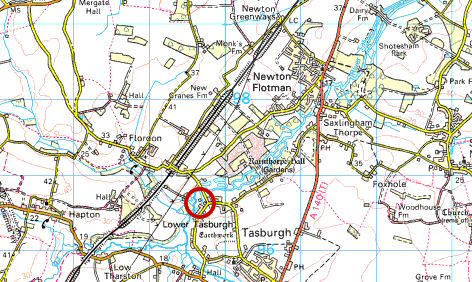 |
|
O.S. Map 2005 Image reproduced under licence from Ordnance Survey |
|
Tasburgh index
of wills 1559: Robert Carre, miller
White's 1845: Zachariah George, corn miller White's 1883: Dennis Blomfield, farmer, miller & merchant - also at Flordon Kelly's 1892: Mrs. Louisa Blomfield Kelly's 1896: Reginald Blomfield, also at Flordon 1896: Mill taken over by William Duffield and converted to a steam roller mill producing two sacks per hour Kelly's 1900: William Lant Duffield Kelly's 1912: William Lant Duffield 1916: William Lant Duffield declared bankrupt Kelly's 1922: Robert John Watling Kelly's 1925: A. E. Thompson & Sons Kelly's 1925: A E. Thompson & Sons c.1935: Mill closed down and converted to residential use March 2016: Mill advertised for sale along with the mill house and 3.08 acres for £1,850,000 April 2021: Mill advertised for sale along with the mill house and 15 acres for £1,600,000 |
If you have any memories, anecdotes or photos please let us know and we may be able to use them to update the site. By all means telephone 07836 675369 or
|
| Nat Grid Ref TM19689661 | Copyright © Jonathan Neville 2003 |